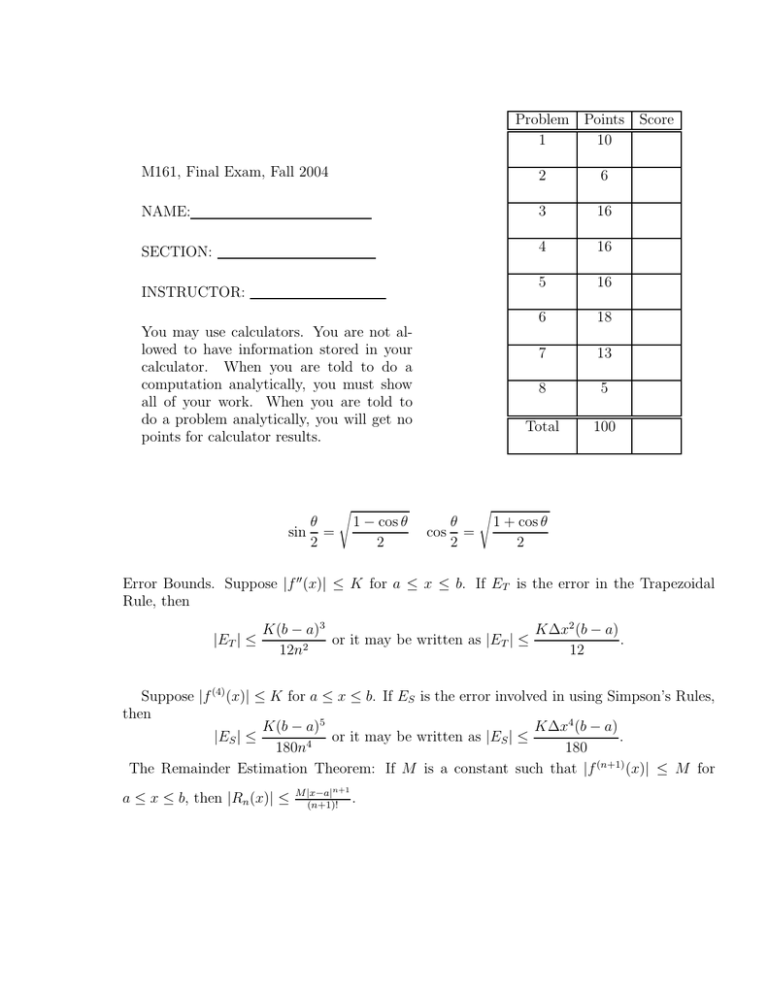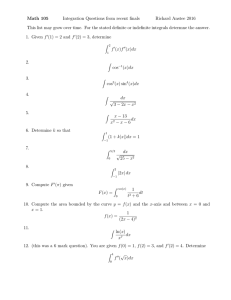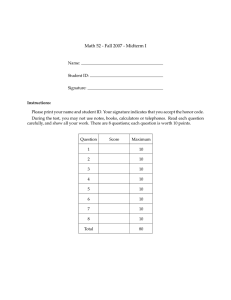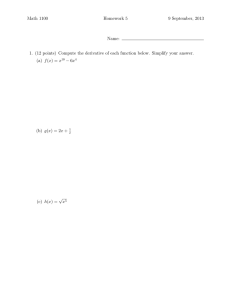Problem Points Score 1 10
advertisement

Problem 1 Points 10 M161, Final Exam, Fall 2004 2 6 NAME: 3 16 SECTION: 4 16 5 16 6 18 7 13 8 5 Total 100 INSTRUCTOR: You may use calculators. You are not allowed to have information stored in your calculator. When you are told to do a computation analytically, you must show all of your work. When you are told to do a problem analytically, you will get no points for calculator results. θ sin = 2 s 1 − cos θ 2 θ cos = 2 s Score 1 + cos θ 2 Error Bounds. Suppose |f ′′ (x)| ≤ K for a ≤ x ≤ b. If ET is the error in the Trapezoidal Rule, then |ET | ≤ K(b − a)3 K∆x2 (b − a) or it may be written as |E | ≤ . T 12n2 12 Suppose |f (4) (x)| ≤ K for a ≤ x ≤ b. If ES is the error involved in using Simpson’s Rules, then K∆x4 (b − a) K(b − a)5 or it may be written as |E | ≤ . |ES | ≤ S 180n4 180 The Remainder Estimation Theorem: If M is a constant such that |f (n+1) (x)| ≤ M for a ≤ x ≤ b, then |Rn (x)| ≤ M |x−a|n+1 . (n+1)! 1. (a) Find the Taylor series expansion of f (x) = summation notation. 1 at a = 0. Write the result using (x − 2)2 (b) For what values of x does the series found in part (a) converge. 2. Suppose that f has the following Taylor polynomial expansion centered at a = 0: T4 (x) = 2 + 5x2 + 4x4 . (a) Calculate f (0) and explain your answer. (b) What can you say about the first and third derivatives of f at x = 0? Explain your answer (please make the explanation short). 3. (a) Simplify (2 + i)(3 + i − 1) . (Write as a + bi, a and b real.) 1+i−3 (b) Write the complex number 1 − i in polar form (in the form reiθ , r > 0 and −π ≤ θ ≤ π). (c) If the polar form of polar form.) √ √ π 3 − i is 2e− 3 i , compute ( 3 − i)23 . (You may leave your answer in √ √ π (d) If the polar form of 3 − i is 2e− 3 i , compute the fourth roots of 3 − i. (You may leave your answer in polar form.) 4. Calculate the following integrals. You must show your work. These integrals must be integrated analytically. For definite integrals give exact answers— no calculator approximations. If you just give the result from your calculator, you willZ get zero credit. 3 (a) 2 x1/3 ln x dx (b) Z 3 1 dx 1 − x2 (c) Z 3 x dx x2 − 1 (d) Z 2 2 sin3 x cos2 x dx 1 , · · ·. 5. (a) Find the formula for the n-th term of the sequence 1, − 13 , 51 , − 17 , 91 , − 11 2n2 + n + 1 if the limit exists. Support your answer with work or an n→∞ 3n2 + n (b) Compute lim explanation. 3 ln n if the limit exists. Support your answer with work or an explanation. n→∞ ln(2n) (c) Compute lim (d) Compute lim x→∞ nation. 2 sinh(2x) if the limit exists. Support your answer with work or an expla4e3x 6. Determine whether the series is absolutely convergent, conditionally convergent or divergent. In any case you must justify your answer. ∞ X (−1)n √ (a) n+5 n=1 ∞ X (b) sin n 2 n=1 n (c) ∞ X n=1 n(n + 1)en π −n 7. (a) Sketch the curve of the parametric equations x = t(t2 − 3), y = 3(t2 − 3), −2 ≤ t ≤ 2 and indicate with an arrow the direction in which the curve is traced as the parameter t increases.(If you need more space, write on the back of the previous page.) 4 2 0 −2 −4 −6 −8 −10 −3 −2 −1 0 x 1 2 3 (b) Find the points on the curve given in part (a) where the tangent line is horizontal or vertical—and draw these tangents on your plot of the curve. (c) Calculate the length of the curve given in part (a). 8. Derive the trapezoidal rule formula for approximating the integral drawing on the plot of f given below that illustrates your derivation. y y=f(x) a b x Z b a f (x) dx. Include a Changes to the Test 1 (b) For what values of x does the series ∞ X n n−1 x converge. n n=1 3 3 (c) should read as follows: (i.e. the 2 in the ”compute...” gets changed to a 3. If the polar form of polar form.) √ √ π 3 − i is 2e− 3 i , compute ( 3 − i)23 . (You may leave your answer in




